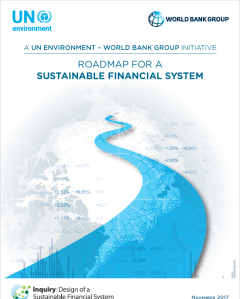The full potential of the financial system needs to be harnessed to serve as an engine in the global economy’s transition toward sustainable development.
The Roadmap for a Sustainable Financial System aims to support the achievement of a financial system that integrates sustainability into its operations — including the full costing of positive and negative externalities — leading to a reorientation of the flow of resources toward more inclusive and sustainable activities. It proposes an integrated approach to accelerating the transformation toward a sustainable financial system that can be used by all financial sector stakeholders and bring policy cohesiveness across ministries, central banks, financial regulators, and private financial sector participants.
The rodmap identifies three types of initiatives that are facilitating the transition toward a sustainable financial system:
1.
Market-based initiatives, such as the Sustainable Banking Network (
SBN) and the United Nations Environment Programme – Finance Initiative (
UNEP FI), that have worked to integrate environmental and social risks and opportunities into their business lines and approaches;
2. National initiatives that, in many cases, arose from national planning processes to implement climate change policies or other long-term strategic development initiatives; and
3. International initiatives, such as the G20, the G7, the UN, and the Financial Stability Board (FSB), which have all addressed different aspects of sustainable and green finance while increasingly involving the private sector, as well as multilateral development banks (MDBs) and other international financial institutions (IFIs) that are actively promoting sustainable finance with initiatives ranging from the adoption of sustainable practices in their core financial activities to the launching of new products aimed at driving capital to sustainable and green applications.
The report is structured around these three drivers of transformation toward sustainable finance. It examines the role of products, information and technologies; business models, capabilities and incentives; national public policy actions and roadmaps, and global coordination principes and results measurements in the promotion of sustainable finance.

